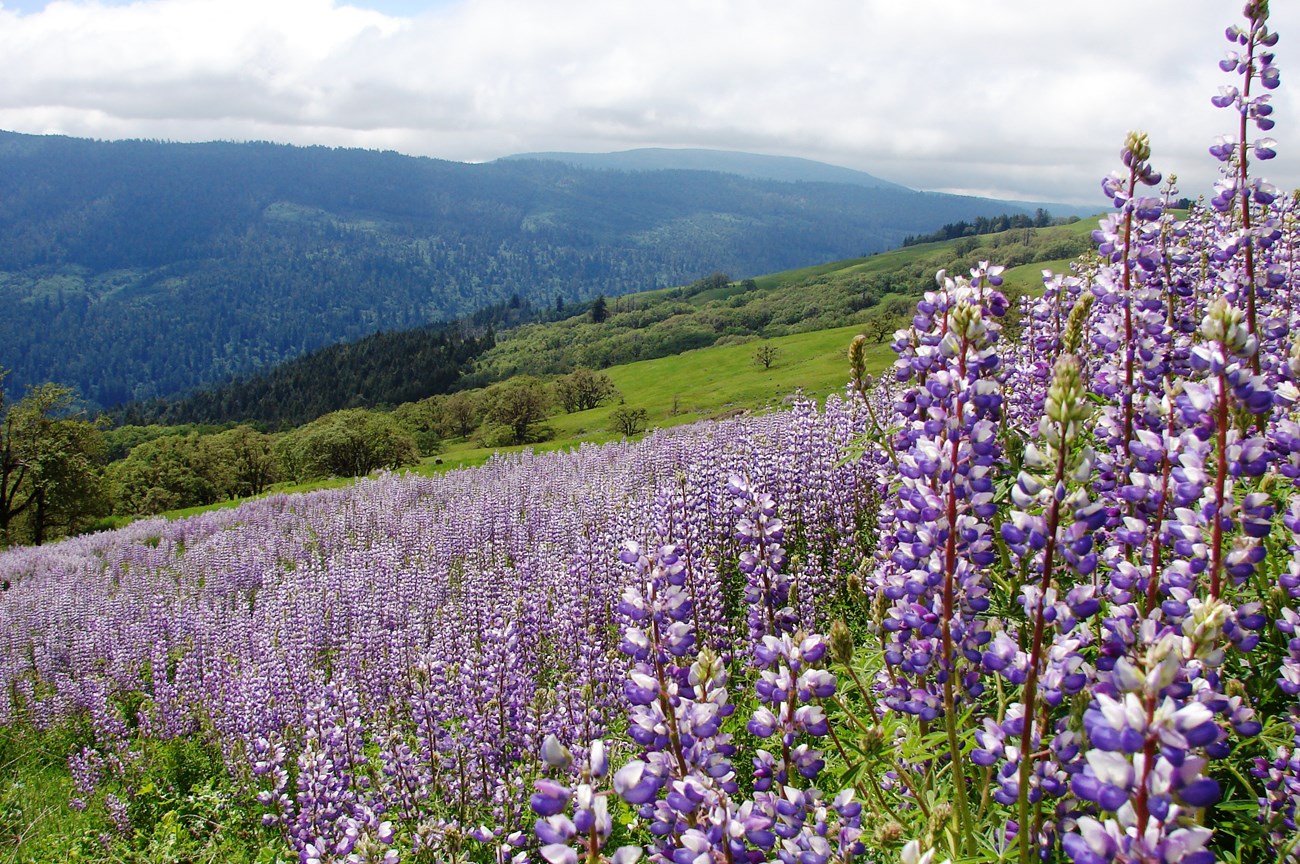Last updated: April 21, 2021
Article
Riverbank Lupine

NPS/Stassia Samuels
General Description
Every few years, a super bloom of lupine flowers draws admirers to the Bald Hills of Redwood National Park in California. From mid-May through June, this colorful purple, blue, and white blanket drapes the Childs Hill and Williams Ridge grasslands on the ridge between the Klamath River and Redwood Creek drainages. The bloom lasts 2–4 weeks. A mix of lupines grows here, including sky lupine (Lupinus nanus) and miniature annual lupine (Lupinus bicolor). The star of this show is thought to be the riverbank lupine, Lupinus rivularis, though further study is needed to resolve a few nonconforming characteristics.
Riverbank lupine is a fast-growing multi-stemmed forb in the pea family (Fabaceae). It has a deep taproot and can grow to 1.5 m (5 ft) tall. Its leaves are palmate—shaped like a hand with fingers spreading out from the center. Its tall, unbranched, flowering stem (raceme) is covered with typical pea family flowers, each having an upper banner and two lateral wings above a crescent-shaped keel. The flowers mature into hairy, gray, mottled seed pods up to 5 cm (2 in) long later in the summer. Unlike typical riverbank lupine, the Bald Hills populations are fragrant, making the whole place smell like grape soda!
Habitat and Distribution
Riverbank lupine typically occurs in well-drained, sandy soils in British Columbia, west of the Cascades in Oregon and Washington, and in northwestern California below 500 m (1600 ft). It thrives in full sun. Because it can fix nitrogen, a vital plant nutrient, through a symbiotic relationship with bacteria in its root nodes, it thrives on soils where other plants struggle, such as on sand dunes or roadside slopes. This ability makes it an early successional, or pioneer, species—one of the first plants to colonize disturbed or other nutrient-poor soils. Its common name, riverbank lupine, derives from its native affinity for riparian (streamside) habitat, though here again, the Bald Hills populations differ by their use of prairie habitat instead.
Ecology
The seeds of riverbank lupine provide food for birds, and its dense patches provide cover for rabbits, birds, and other small animals. Native bees, especially bumblebees, are attracted to its pollen and nectar. It’s also thought to be a potential butterfly host plant for the orange sulphur (Colias eurytheme) and the western tailed blue (Cupido amyntula).
Fire appears to play a role in the super bloom of Bald Hills lupines. Park managers discovered this when a noticeable super bloom arrived in 1999, 2 years after a large prescribed burn in the area in 1997. Then it happened again—a super bloom in 2009 followed 2 years after prescribed fire in 2007. Some plants, like this lupine, produce hard-coated seeds that germinate more easily when scarified (weakened), building up in the soil until a fire comes along. This may be one explanation for the Bald Hills super bloom.
This fire–super bloom connection was likely observed by the indigenous inhabitants of the Bald Hills—the Chilula and Yurok Tribes— who regularly burned these prairies. Changes to the landscape from fire enhanced the tanoak acorn harvest and grass seed production, supported deer and elk hunting, and improved the quality of basketmaking plant materials, such as the shoots of hazel trees.
Reproduction
Riverbank lupine is a perennial plant—its persistent rootstock generates new growth each summer for several (>2) years. Lupines in the Bald Hills, however, behave more like biennials, taking two years to complete their full lifecycle. Flowers that bloom in spring and early summer form pods containing 6–10 seeds that fall onto the soil or are spread by birds. Seeds that germinate the next spring produce a leafy, nonflowering stage of the plant (rosette), which then flowers a year later.
Human Uses
Plants in the genus, Lupine, are used in a variety of ways by humans. The seeds of some lupine species, known as lupin beans, have long been part of the Mediterranean diet. People occasionally have allergic reactions to lupine, however, (lupines are in same family as peanuts), and some species are toxic. Their showy and mildly fragrant flowers decorate landscapes as ornamentals. Farmers sow them as a winter cover crop to add both nitrogen and organic matter to the soil. Restoration seed mixes may also include these hardy pioneers that can establish in disturbed soils and enrich the soil. Riverbank lupine was reportedly used for its medicinal properties by the Thompson Indians of British Columbia.
Conservation
Riverbank lupines are not a conservation concern, except in British Columbia, at the northern extreme of their range.
Where to See
In Klamath Network parks, riverbank lupine is limited to Redwood National and State Parks, but a variety of different lupine species occur in all network parks. Watch for a potential super bloom at Redwood in 2021 after planned burns in the Bald Hills in 2019.
More Information
https://www.nps.gov//redw/learn/nature/whenbloom.htm
https://redwood.forestthreats.org/baldhillsfire.htm
Download a pdf of this article
Prepared by Sonya Daw
NPS Klamath Inventory & Monitoring Network
Southern Oregon University
1250 Siskiyou Blvd
Ashland, OR 97520
Featured Creature Edition: May 2019
